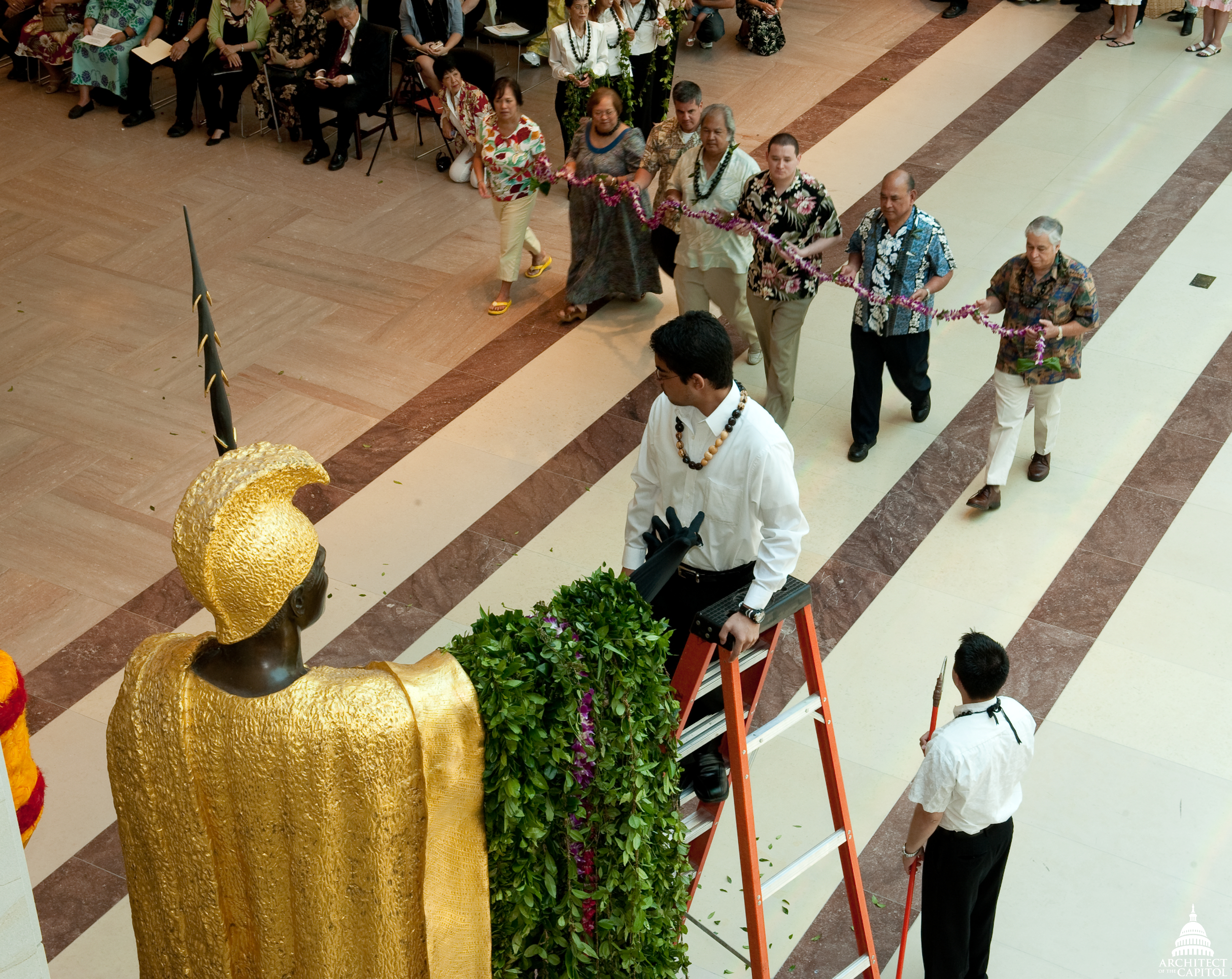Highlights
This statue of King Kamehameha I was given to the National Statuary Hall Collection by Hawaii in 1969.
King Kamehameha I was born at Kokoiki in the Kohala district of the Island of Hawai'i about 1758. He grew into a courageous warrior and was said to have overturned the huge Naha Stone in Hilo. According to native belief, such a feat indicated superhuman strength and foreshadowed the inevitable conquest of all of Hawai'i.
Upon the death of his uncle, Chief Kalaniopu'u, Kamehameha received custody of the war gods and the temples, while the late chief's son, Kiwala'ō, inherited the island. However, district chiefs became dissatisfied with Kiwala'ō's methods of redistricting the lands. A struggle ensued between Kiwala'ō's forces and the various chiefs under the leadership of Kamehameha. His cousin was killed, and Kamehameha attained control of half the Island of Hawai'i. During the struggle, Kamehameha's "divine right" was exemplified by a rare explosive eruption of Kīlauea Volcano, which wiped out parts of the opposing army.
In 1785 Kamehameha married Ka'ahumanu, the daughter of one of his most trusted advisors. In 1790, after attaining control of the remainder of Hawai'i Island, he successfully invaded the Islands of Maui, Lāna'i, and Moloka'i. By 1810, he had unified all the inhabited islands of Hawai'i under his rule.
As king, Kamehameha placed capable followers in charge of large districts. He encouraged trade and peaceful activities, and he presided over the opening of Hawai'i to the rest of the world. On May 8, 1819, King Kamehameha I, also referred to today as Kamehameha the Great, died at Kailua in the district of Kona on his home Island of Hawai'i. His remains were hidden with such secrecy, according to ancient custom, that "only the stars know his final resting place."
The Statue
American sculptor Thomas R. Gould depicted Kamehameha in his regal garb, including a helmet of rare feathers attached to woven plant fibers. The gilded cloak is based on one that Kamehameha's subjects made for the king by weaving yellow feathers of native birds into a fine mesh net. The sandals, although not historically accurate, suggest the type of footwear that Kamehameha would have worn. The spear in his left hand symbolizes the ability to defend oneself and one's nation; it is also a reminder that Kamehameha ended the wars among the Hawaiian people. His right hand is extended in a gesture of aloha, the traditional spirit of friendly greeting.
Gould was commissioned to create a statue of Kamehameha by the legislature of the Kingdom of Hawai'i and modeled the figure at his studio in Rome in 1879. It was cast in bronze at a Paris foundry in 1880 but was lost in a shipwreck on its way to Hawai'i. A second statue was cast from the same model and arrived safely; it was unveiled by Hawai'i's last king, Kalakaua, in 1883 in front of the Judiciary Building in Honolulu, where it still remains. The first statue was subsequently recovered and brought to Hawai'i; in 1912 it was placed at Kohala Court House in Kapa'au on the Island of Hawai'i, in Kamehameha's home district.
The statue in the Capitol was made from molds taken of the Honolulu statue. It was dedicated along with a statue of Father Damien, Hawai'i's other gift to the National Statuary Hall collection, at a ceremony held on April 15, 1969 in the Capitol Rotunda. The statue was moved to National Statuary Hall in June of that year. The great weight of the bronze statue and its solid granite base (over 6 tons) make it one of the heaviest objects in the collection, so a major factor in its location is the need to support it safely. In 2008 the statue was moved to Emancipation Hall in the Capitol Visitor Center.

Every year on Kamehameha Day (June 11, a state holiday in Hawai'i), Emancipation Hall is the scene of a ceremony in honor of the king. The statue is draped with garlands of flowers from Hawai'i, and hula dancers perform before portrayers of Kamehameha and Ka'ahumanu.

